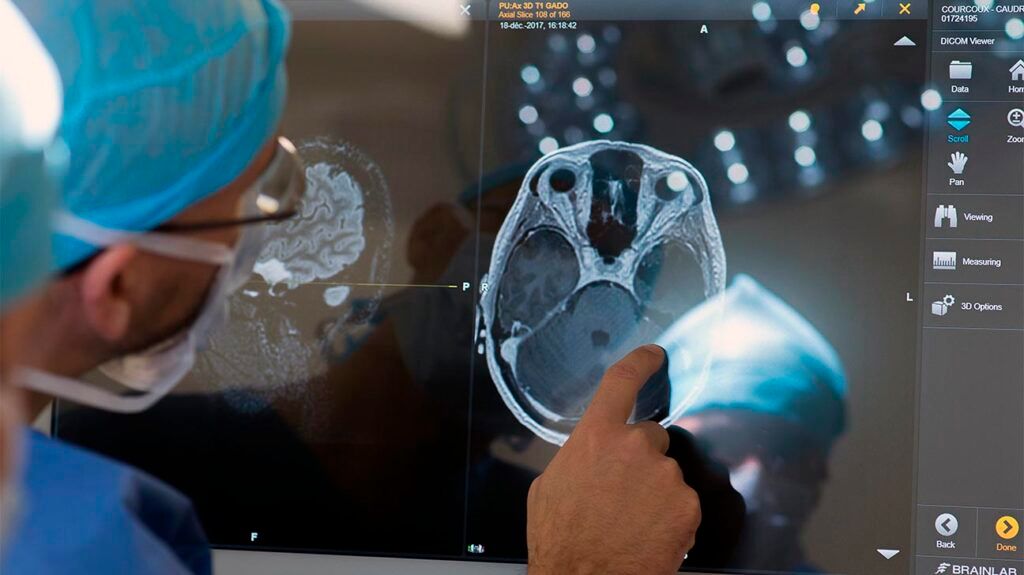Awake brain surgery is a safe and effective treatment for several brain conditions. Although it may be intimidating for a person to be awake during brain surgery, this is often an essential part of the operation.
People with brain tumors may need surgery to remove them. They may undergo a major type of brain surgery called a craniotomy, which involves removing part of the skull so surgeons can operate on the brain.
Surgeons perform some craniotomies when someone is asleep under a general anesthetic. However, in some circumstances, they may perform one to remove tumors when a person is awake. They may also perform awake brain surgery for other purposes, such as surgically treating epilepsy.
During the surgery, a person talks with a surgeon and the surgical team as part of the operation. The surgical team also ensures the individual feels comfortable and experiences no pain throughout the procedure.
This article discusses awake brain surgery, who may need it, and its associated risks. It also explores what to expect during and after surgery.

Awake brain surgery, or awake craniotomy, is a procedure that surgeons use to treat some brain conditions. Craniotomies are the most common type of operation surgeons use to treat brain tumors. During awake brain surgery, a surgical team temporarily removes part of a person’s skull and operates on the brain.
The team may sedate or anesthetize the person when removing part of their skull or scalp. The individual is typically
Having a person awake during brain surgery enables the surgeon to complete tasks that offer essential feedback to the healthcare team.
Healthcare professionals call this technique cortical mapping. The method allows surgeons to check the function of different parts of the brain by stimulating its various parts. Doing so helps the surgeon remove as much of the tumor as possible with minimum risk.
People may find the concept of awake brain surgery concerning or frightening. Therefore, the surgical team will counsel and help a person prepare for the surgery beforehand. They will also make sure they are as comfortable as possible during the operation. Awake brain surgery is generally a
People with a brain tumor or epilepsy may need awake brain surgery.
Surgeons use this technique
- speech
- movements
- sensations
Surgeons also use awake brain surgery for:
- surgically treating epilepsy
- deep brain stimulation to surgically treat conditions such as:
- a brain biopsy, a procedure to obtain tissue from the brain for analysis
- ventriculostomy, a surgical procedure to allow excess brain fluid to drain into the spine
- interventional pain procedures, which are surgeries to control acute or chronic pain conditions
As with all surgical procedures, there may be complications from awake brain surgery. The main complication or risk is the risk of a person having seizures.
Seizures
Other risks may include:
- hypertension, or high blood pressure
- nausea or vomiting
- airway complications
- air embolisms
- being unable to map the brain during cortical mapping, which is known as a failed awake craniotomy
There are also risks in not having awake brain surgery for people with brain tumors. Without treatment, the tumor may continue to grow, causing permanent brain damage.
A person can speak with a healthcare professional about what to expect before and after awake brain surgery.
Before surgery
People can continue their usual daily activities before awake brain surgery. They should continue to take any medication unless the surgical team tells them to stop. People
Before a person’s awake brain surgery, they will meet with healthcare professionals to help prepare for the operation. They may prescribe specific medication for them to take before surgery.
They can eat solid foods until 6 hours before the surgery. They can also drink fluids until 2 hours before the procedure.
During surgery
During surgery, anesthetists use an IV in a person’s arm to administer mild sedatives through a vein. These help them feel comfortable and relaxed. A person may also have a catheter to monitor fluid output and avoid needing comfort breaks.
Surgeons inject local anesthetic when operating on the skull to access the brain. They use a clamp to hold a person’s head in place painlessly.
Surgeons then use an image guidance system with a monitor to find the precise location of the tumor. Before making any cuts, the surgeon checks with the person to ensure they do not feel any pain. They may use a noisy drill to operate, but it is not painful.
Once the surgeon has access to the brain, they use cortical mapping to check the functions of different areas of it. This may include the person performing specific tasks involving:
- speech
- language
- movements, such as moving their toes
After completing the cortical mapping, the surgeon removes as much of the tumor as possible. The person will continue to complete tasks as they do so.
After removing the tumor, the surgeon closes the access point into the skull and stitches the scalp up. The surgical team then takes the person to a recovery area. People may feel tired after the operation.
For at least
Healthcare professionals
The following are answers to common questions about awake brain surgery.
What is the success rate of awake craniotomy?
In a 2021 study of 469 people who had awake craniotomy, 1.7% had permanent side effects after surgery.
Do you feel anything during awake brain surgery?
People do not typically feel anything during awake brain surgery, as the brain tissue is
Surgeons use awake brain surgery to remove brain tumors and treat other conditions. During the surgery, a person typically stays awake so they can talk with the surgeon. This allows them to complete tasks that aid surgeons in accurately mapping the sections of their brain.
This process is called cortical mapping. It helps the surgeon remove the tumor without affecting other areas of the person’s brain.
People do not feel pain during awake brain surgeries, which are typically safe, successful, and effective procedures.
